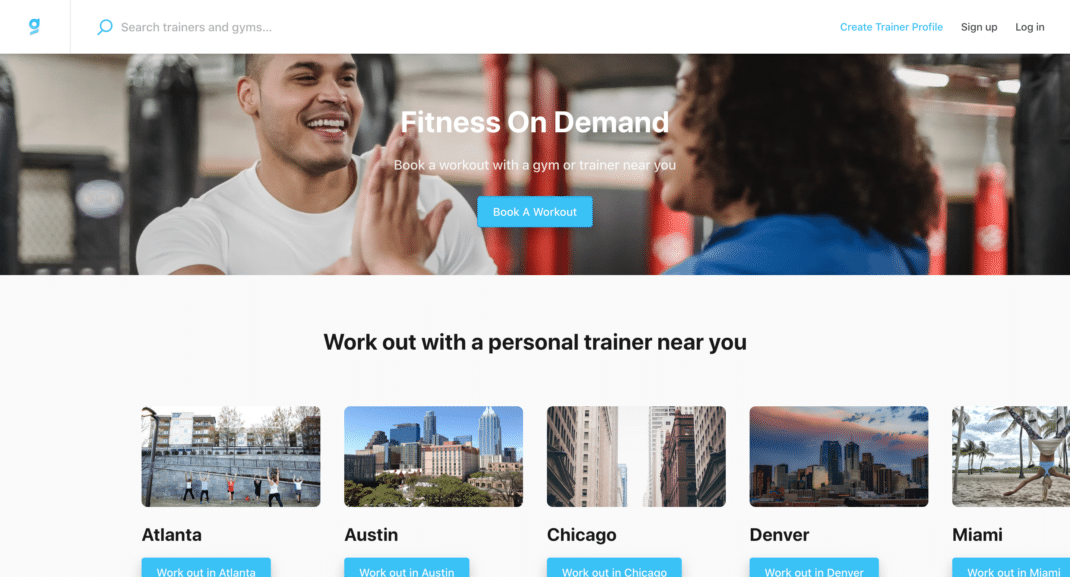The Place to Be!
Market your classes for bigger numbers and more fun.
Group exercise classes are like restaurants. An eatery may boast an outstanding chef and serve delicious meals, but passersby who spot only a smattering of diners might be reluctant to eat there. To find out how the food actually tastes, they must risk trying it. A scantily attended class also presents a risk. Participants might wonder if the small class size reflects the quality of the workout. Will this be a good use of their time? Will they feel too conspicuous if they can’t follow the moves or decide to leave?
A full house and a nightly line out the door are excellent advertising for any restaurant. The same holds true for group exercise. Picture a bustling studio. Prospective students might assume that a large, energetic class is more fun, has a better instructor and offers a superior workout to the poorly attended class before it.
So what makes a class popular? A good time slot helps. Being an approachable and/or technically talented instructor can also attract participants, but it’s no guarantee. Some technically mediocre instructors are popular because people are drawn to their personalities or some other aspect of their teaching styles. Their packed classes are the equivalent of a restaurant line out the door. Members vie for limited space because they want to be part of the action. Create this kind of buzz in your classes through marketing and positive word of mouth.
Teaching to small numbers can be just as rewarding as leading a larger crowd. Small groups are intimate; they allow for more personal attention. Indeed, instructors usually earn the same wage whether they lead five or 50 people. However, striving for increased attendance can lead to important benefits for your career, the facility and participant motivation.
Stimulating Success. Large, lively classes are highly enticing. More people usually generate more energy. You might also find it easier to be motivated by teaching a class of 25 as opposed to a group of five.
Magnetic Numbers. People attract people. Bigger classes draw even more people. Think back to the restaurant example. It feels less risky to step into a full studio than a scarcely populated one.
Avid group exercisers tend to hype the busy “in” classes, touting them as the most fun and worthwhile, regardless of how they actually compare with other workouts. Those who find fitness classes intimidating may be more inclined to attend if they can inconspicuously “hide” in a big group.
Approval From Management. Owners and managers look at the group exercise department from a business perspective. Your manager might track attendance and crunch numbers to determine the program’s profitability. Business is booming in classes that satisfy more members. If your attendance is low, you may feel pressure from management to pick up the numbers.
Higher Wages. Fair or not, the most popular instructors are often more apt to receive raises. These instructors have solid negotiating power because they pack classes. Remember, group exercise is business. Of course credentials, experience, knowledge, reliability, versatility, passion, compassion and personality all count. Add popularity to these attributes and you’ve got the complete package.
Enhanced Career Potential. If you aspire to become a manager or presenter, your ability to create abundant attendance is a career selling point.
Just because a class exists on the schedule doesn’t mean people will join it. Surprisingly, many members aren’t aware of every option. Simple strategies can have a significant and positive impact on class numbers. Think of marketing as ongoing communication to customers (group exercise participants) about why they should do business with you (attend classes). Marketing requires creativity, patience and consistency; it’s not about instant gratification. It’s an ongoing effort toward your goal of bigger classes.
You don’t have to spend a lot of money on flashy promotions or gimmicks to market group exercise. All the ideas presented here are low-cost or no-cost. Before you start, however, communicate your intentions to your manager. It’s vital that he or she be informed about and condone your strategies and goals beforehand. Keep in mind that marketing your own classes isn’t about competing with other team members. Think “abundance mentality.” If you boost your class numbers, they can do the same! In other words, there are enough participants for everyone to maintain high numbers or to build better attendance.
Marketing your group exercise classes is simple if you break it down into three specific phases that include the following objectives:
- Increase participation by persuading new people to attend your class.
- Use great customer service to keep exercisers in the class from start to finish.
- Inspire participants to return week after week, and motivate them to bring their friends. This is your ultimate objective.
The ideas that follow will help you to build your class numbers and to develop an ongoing marketing plan.
Phase 1: Bring ’em In
Be Visible. Get members to recognize you and see you as a familiar face. You probably already sub classes to help out other instructors. Why not consider subbing as a marketing strategy as well? Get in front of participants who might not otherwise come to your classes, and charm them with your teaching skills and personality. Seek out subbing opportunities in similar formats or time slots to your own. Don’t forget to announce which classes you regularly teach.
Another approach is to present miniworkshops or seminars, suggests Suzanne Gove, a personal trainer and group exercise instructor in Roseville, California. The week before beginning a new class, she hosted a meet-and-greet miniworkshop that included 15-minute demonstrations of the new equipment she’d be using. “Getting the chance to meet prospective participants face to face, especially those who were initially hesitant to try the new workout, was a great way to market the class and my instructing style,” she says. “I see many of the participants I met during that event in my classes now.”
Develop Relationships With Other Staff. Why not cross-promote similar classes with another instructor? Perhaps you teach an athletic cardio class on Tuesday mornings. Approach the instructor who teaches the interval step class on Friday morning and suggest you promote each other. Participants interested in your class will likely be interested in his and vice versa.
Invite a personal trainer to assist with participants’ technique during your strength or flexibility classes. The experience allows the trainer to market her services to a large group. And chances are, when she’s in a position to recommend a class to her clients, she’ll mention yours.
Get the Word Out. Sometimes members aren’t even aware that you offer a class they’d benefit from. Gove has a simple solution. While doing an exercise in one class, she mentions a related exercise she taught earlier that week in a different class. She addresses a regular participant, saying, for example, “Jane, you were in my ‘Muscle Sculpt’ class on Saturday. How do these lunges compare to the squats we did then?”
“The interaction creates a social feeling and also piques the interest of participants who might not have known about the Saturday class,” Gove says.
Another idea for creating awareness is to post colorful signs in the changing room or around the facility (remember to pass this idea by your manager first). Effective signs are visually uncluttered and have clearly written text highlighting how your class benefits members. Refer to the “Getting Started With Marketing” work sheet, above, for help in determining which benefits to highlight.
Phase 2: Keep ’em There
Most instructors have been disheartened by a disgruntled participant leaving in the middle of class. One way to avoid this scenario is to create a bond with exercisers from the moment they enter the studio to the time they leave.
Connect With Participants. The preclass setup and warm-up create powerful first impressions. Connect before class by introducing yourself to new students and chatting with regulars. A new participant might be less likely to duck out early if you’ve already made contact with him.
Light a Fire. Start the workout with energy and gusto—the first moments of the warm-up make a lasting mark. Don’t save all your enthusiasm for the cardio.
Personalize the Experience. Learn names and acknowledge students during class—this is a smart way to create associations. Penny Cardas of Vancouver, British Columbia, uses this technique in every class to strengthen her relationships with participants. A personal trainer and group exercise instructor with 18 years’ experience, Cardas says it’s incredibly motivating for a participant when you approach her, address her by name and praise her efforts. “I’ve had women come up to me, quietly, after class to introduce themselves. And they’ve asked me—flat out—if I would use their names in class. When I do, they feel special. They feel connected to me, they feel noticed and they feel they matter. Using names and offering acknowledgement have become even more important than I realized when I first started the technique,” says Cardas.
Phase 3. Inspire ’em to Come Back Every Week
It’s easier to motivate regulars to return than to persuade new prospects to join, so don’t take the familiar faces for granted. If you want to inspire attendance, go above and beyond to create a community.
Exceed Expectations. Go out of your way to help students. Perhaps a new member shows up for your indoor cycling class only to discover that the class is full, even though he preregistered. Offer to personally register him for your next class in advance so he’s assured a bike. Call the day before to remind him of his guaranteed spot. Thanks to your gesture, he may become a regular participant who spreads positive word of mouth about you and your class.
Foster a Social and Emotional Tie to Your Class. Encourage participants to learn each other’s names. Using students’ names during class, as described earlier in this article, helps achieve this goal. Avoid subbing out your class whenever possible; your consistent presence is important to regulars.
Encourage participants to invest emotionally in the class. For example, invite them to bring in their favorite relaxing song and play a different participant’s song during the stretch portion of each workout. Students enjoy hearing their musical contributions.
Applying these simple marketing ideas (and dreaming up more of your own) can lead to bigger classes that are more fun and motivating for you and participants. Remember that any marketing effort you make helps boost your career and inspire the world of group exercise to fitness.
Personal fitness trainers (PFTs) receive plenty of expert advice on how to attract clients through marketing. Smart PFTs stay on top of new and effective marketing techniques. Group exercise instructors can learn an important marketing lesson from PFTs. After all, we also are expected to garner and maintain a decent-sized client base (i.e., our classes).
Learn from the following common PFT marketing tools, and brainstorm how you can apply these concepts to market group exercise.
The first step in developing your marketing plan is to ask yourself the following questions:
1. Who are my target participants?
2. What are their most important wants and needs?
3. How does my class satisfy these wants and needs?
Use the information you gather from these exercises to attract the right participants, pinpoint your efforts and create effective marketing material.
Think you don’t have anything to tout in group fitness? The following areas are highly marketable:
Class Format. Many participants are easily drawn to new and trendy exercise styles and formats. Do you teach a core-conditioning class? Market that format, plugging it as one of today’s top trends, according to IDEA’s latest survey results.
Class Equipment. Some classes use equipment that’s highly marketable. If stability balls or other types of balance equipment are popular at your facility, advertise that you use them in your classes. This approach also works well with new equipment that members are eager to try.
Yourself. Market special skills and experience that make you particularly qualified to teach. Are you a mom of four who instructs prenatal yoga? Would your black belt in karate help market your kickboxing class? Let members know about what they’re missing!
Amanda Vogel, MA
Amanda Vogel, MA, is a fitness professional and the owner of Active Voice, a writing, editing and consulting service for fitness professionals. She writes for IDEA, Health, Prevention, and Self, and has co-authored books on postnatal fitness and yoga. With a master's degree in human kinetics, Amanda has worked in the fitness industry for more than 15 years, including time spent as a program director and vice president for a chain of all-women clubs in Vancouver, British Columbia.






